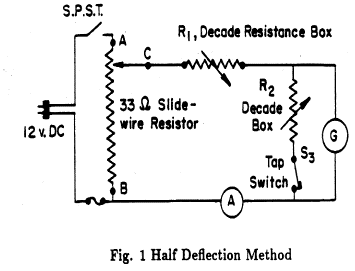Purpose: To Design and Construct a Voltmeter and an Ammeter
Before designing a voltmeter or ammeter from a galvanometer it is
necessary to determine the resistance of the galvanometer, Rg,
and the value of the current which causes the galvanometer to read full scale, I f . These values are
often stamped on the galvanometer by the manufacturer. We shall find Rg
using the half deflection method and the circuit in Fig. 1. BE VERY CAREFUL NOT TO PASS TOO LARGE A CURRENT THROUGH THE GALVANOMETER
. Before plugging the line cord in, set R1
= 25,000 ![]() and R2 = 1
and R2 = 1 ![]() . Turn on the
current and adjust R1 to
produce a full scale deflection on the galvanometer with S3
open. Then close S3
and adjust R2 until
you obtain a half-scale deflection. If R1 >> R2
then Rg
. Turn on the
current and adjust R1 to
produce a full scale deflection on the galvanometer with S3
open. Then close S3
and adjust R2 until
you obtain a half-scale deflection. If R1 >> R2
then Rg ![]() R2 . If R1 is not much greater than R2 this approximation is not good. You
will get best results if the voltage divider is set to give maximum voltage to the circuit
and R1 >> R2 to begin with. If the slide wire gets to end A and you still do not have full
scale current in the galvanometer TURN OFF the current and start over with a reduced value of R1
(8000
R2 . If R1 is not much greater than R2 this approximation is not good. You
will get best results if the voltage divider is set to give maximum voltage to the circuit
and R1 >> R2 to begin with. If the slide wire gets to end A and you still do not have full
scale current in the galvanometer TURN OFF the current and start over with a reduced value of R1
(8000 ![]() ). The full scale current of the galvanometer is
read directly from the ammeter when S3 is open. For this determination use the 15mA scale of theVOM for the
ammeter.
). The full scale current of the galvanometer is
read directly from the ammeter when S3 is open. For this determination use the 15mA scale of theVOM for the
ammeter.

Design of a Voltmeter
In addition to determining Rg
and I f you must also select a voltage V which you wish to cause a full-scale deflection. This is your choice, determined
by the intended use of the voltmeter. The only restriction of V is that it must be greater than or equal to If
![]() Rg (Why?)
Rg (Why?)
The voltmeter is constructed by wiring a resistor R in series with the galvanometer as shown in Fig. 2.

When the potential difference between the voltmeter terminals T1 and T2 is V, the current through G must be If . Summing the voltage drops across R and Rg, in this case, gives
V = If ![]() R +If
R +If ![]() Rg
Rg
This can be solved for R to yield
R = V/If - Rg
Design of an Ammeter
1. Just as it was necessary to choose a full-scale voltage for the voltmeter so it is necessary to select a current I which you wish to cause a full-scale deflection. Again this choice is based on the intended use of the ammeter and is limited only by the condition I > If . (Why?) The ammeter is constructed by wiring a resistor R, called a shunt, in parallel with the galvanometer as shown in Fig. 3.

When the current I is in the ammeter, you want If as the current through the galvanometer and, by subtraction, I-If through R. Since the voltage drop across Rg must be the same as the voltage drop across R(Why?), the following equation holds.
If ![]() Rg =
(I-If)R or R = If
Rg =
(I-If)R or R = If ![]() Rg/(I - If)
Rg/(I - If)
2. Ayrton Shunt Method. Sometimes a shunt resistance needed is
too low for the resistances actually available (e.g. need 0.007 ![]() , but only have 1
, but only have 1 ![]() ). The lowest available resistance can be used as Rx
, but another resistance, Ry
, must be put in series with Rg
to protect the galvanometer. Generally, if Rx
is used,then Ry should be: Ry = ([I/If] -1)Rx -Rg
). The lowest available resistance can be used as Rx
, but another resistance, Ry
, must be put in series with Rg
to protect the galvanometer. Generally, if Rx
is used,then Ry should be: Ry = ([I/If] -1)Rx -Rg

Procedure:
Questions: